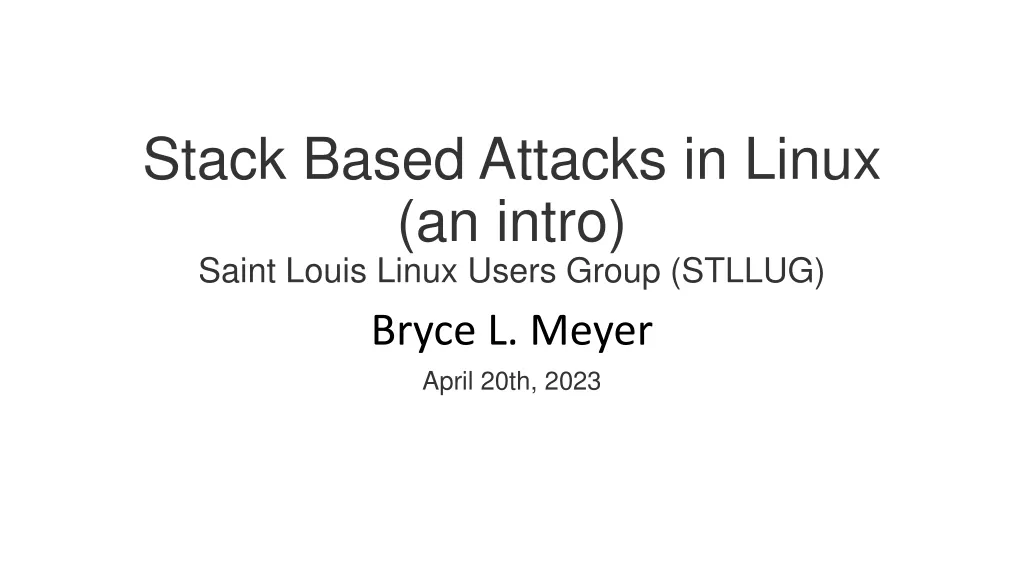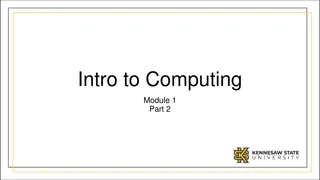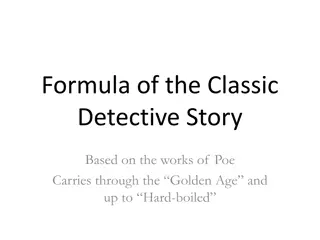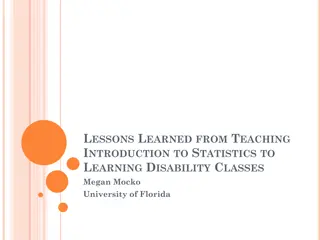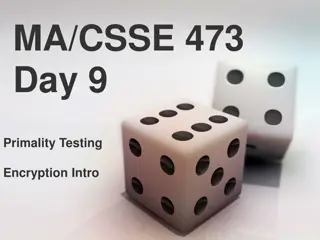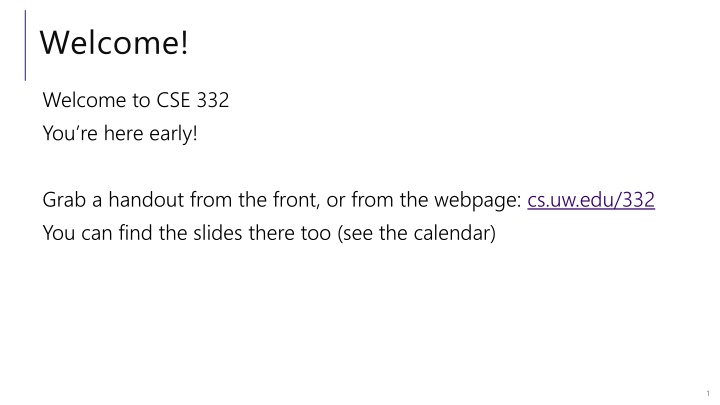
CSE 332 Spring Lecture: Overview and Logistics
Dive into the world of CSE 332 with this early welcome message! Get familiar with the course mechanics, staff, goals, and logistics. Discover what's in store for you in terms of data structures, parallelism, and exercises. Stay ahead by checking out the helpful links and starting your journey towards becoming a proficient computer scientist.
Download Presentation

Please find below an Image/Link to download the presentation.
The content on the website is provided AS IS for your information and personal use only. It may not be sold, licensed, or shared on other websites without obtaining consent from the author. If you encounter any issues during the download, it is possible that the publisher has removed the file from their server.
You are allowed to download the files provided on this website for personal or commercial use, subject to the condition that they are used lawfully. All files are the property of their respective owners.
The content on the website is provided AS IS for your information and personal use only. It may not be sold, licensed, or shared on other websites without obtaining consent from the author.
E N D
Presentation Transcript
Welcome! Welcome to CSE 332 You re here early! Grab a handout from the front, or from the webpage: cs.uw.edu/332 You can find the slides there too (see the calendar) 1
Welcome to CSE 332 CSE 332 Spring 25 Lecture 1 2
Outline Course Mechanics Start of content -Review of queues and stacks 3
Your TODO list Make sure you re on Ed. Get started on Exercise 0 (and update your IDE/java installs while you re at it). 4
Staff TAs Jacklyn Cui Charles Hamilton-Eppler Anthony He Aaron Honjaya Yafqa Khan Alysa Meng Cindy Ni Juliette Park Hana Smahi Samarth Ramya Venkatesh Iris Zhao Rubee Zhao Jolie Zhou Instructor: Robbie Weber Ph.D. from UW CSE in theory Fifth year as teaching faculty Office: CSE2 311 Email: rtweber2@cs.washington.edu
Whats in this course? Data Structures and Parallelism Data structures and Algorithms (about 70% of the course) -Starting to really think like a computer scientist. -Make design decisions, think about trade-offs. -Core data structures and algorithms (timeless, classic material). -Mathematically analyze those structures and algorithms. -Implement them Implement them Parallelism -First serious treatment of programming with multiple threads 6
Goals By the end of the quarter you will -Understand the most common tools for storing and processing common data types. -Consider tradeoffs between tools you could use. So that you can -Make good design decisions on your code -Justify and communicate those decisions 7
Logistics Textbook: Weiss, Data Structures and Algorithm Analysis in Java OPTIONAL (useful if you want more info, or an alternative presentation) Ed (message board). Gradescope. You were invited to Ed and Gradescope already (if you were registered by last Friday) 8
Logistics Exercises Assigned throughout the quarter, about 15 in total. We ll usually have two per week. -Usually one due on Monday; one due on Friday (except at the end of the quarter) -About half programming, half theory (at most one of each type per week) Starting earlier is better (they can take some thought and/or some debugging). We ll count the 12 highest scores, drop the others. 9
Logistics Late Days You have 6 late days to use during the quarter; a late day lets you submit 24 hours later than you would have otherwise. You can use at most 2 late days per exercise. 10
Logistics Exams Midterm Midterm Wed Apr 30, 6-7:30 PM. Final Final Thursday June 12th 12:30-2:20 Both are combined exams (same time regardless of which section you re in). Please read the conflict policy in the syllabus if you might not be able to make those times. 11
Logistics Work Grade Breakdown Final: 25% Exercises: 60% Midterm: 15% Exercises Midterm Final 12
Logistics Section Sections start this week -Chance to practice problems about what we learned in lecture. -Occasionally learn new material We won t record sections. Please strongly consider attending section in-person the ability to discuss and ask questions in the smaller setting is hard to replace by just looking at the handout. -But participation/attendance is not not tracked 13
Academic Honesty High level discussion is fine. High level means you won t look at someone else s code, nor at their half-finished (or fully finished) writeup for the theory exercises But you must: -Not take any written notes away from your discussion. -List everyone you collaborated with on your assignment. -Take a 30-minute break between your discussion and writing/coding up your assignment. Goal is for you to learn the material. More details, including examples, on the webpage later this week. 14
Abstract Data Types An Abstract Data Type (ADT) Mathematical description of a thing and a set of operations to interact with that thing. Mathematical, think like 311 --- precise enough you could do a proof on it (not necessarily a bunch of numbers ) Thingthink organized data 16
Abstract Data Type An Abstract Data Type (ADT) Abstract Data Type (ADT) is a mathematical definition of an object with operations to interact with that object. Queue ADT state state Set of elements Stack ADT state state Set of elements behavior behavior push(element) push(element) add a new element to the collection. behavior behavior enqueue(element) enqueue(element) add a new element to the collection. pop() pop() returns the element that has been in the collection the shortest, and removes it. peek() peek() find, but do not remove the element that has been in the collection the shortest. dequeue() dequeue() returns the element that has been in the collection the longest, and removes it. peek() peek() find, but do not remove the element that has been in the collection the longest. 17
Why Define an ADT? ADTs let us: Identify patterns more easily: Identify patterns more easily: When you say hey, I need an object that gives me back the thing I put in most recently can remember what does that if it has a name. Stacks show up in: the call stack (managing recursion), algorithms for handling context-free grammars, depth-first search (we ll see it later this quarter), and more Communicate more easily: Communicate more easily: Telling someone keep track of this data on a stack is easier than make a linked list, and when you insert or remove update the head, not the tail, and keep track of the size, and Reuse code!: Reuse code!: Implement stacks once (or maybe a handful of versions) and reuse 18
What Data Structures for a Queue? A data structure is a specific organization of data (and associated algorithms) to implement an abstract data type. How would you implement a queue? I.e., what data structure would you use? 19
Data Structure A clever way of organizing data points -A data structure is an implementation of an ADT. Ways to implement a queue Array 17 3 4 13 10 15 LinkedList head tail 7 23 15 14 20
Circular Array A different queue implementation Removing elements is expensive. What if we just remember where the next element is? front back 17 3 4 13 10 15 //sketch only Enqueue(item) { Q[back]=item; back = (back+1) % size; } //sketch only Dequeue() { item = Q[front]; front = (front-1) % size; return item; } 21
Circular Array What about insertions? We can wrap around (At least until the array is completely full. ) front back 17 3 4 13 23 10 5 15 //sketch only Enqueue(item) { Q[back]=item; back = (back+1) % size; } //sketch only Dequeue() { item = Q[front]; front = (front-1) % size; return item; } 22
Circular Array Sketches don t handle: What if queue is empty (for either enqueue or dequeue) How do you test if it s empty What if array is full? Keeping size up to date Etc. A different queue implementation Removing elements is expensive. What if we just remember where the next element is? front back 17 3 4 13 10 15 //sketch only Enqueue(item) { Q[back]=item; back = (back+1) % size; } //sketch only Dequeue() { item = Q[front]; front = (front-1) % size; return item; } 23
Linked List What do Enqueue and Dequeue look like? What are their time complexities? head tail 7 23 15 14 24
Linked List What do Enqueue and Dequeue look like? What are their time complexities? //sketch only Enqueue(item) { tail.next=new Node(item); tail=tail.next; } //sketch only Dequeue() { item = head.data; head = head.next; return item; } Still just sketches! Ask the same questions from the circular array. Notice that sometimes the answer is don t worry about it ! 25
Tradeoffs What makes the circular queue implementation different from the linked list implementation? In what ways is one more desirable than the other? 26
Tradeoffs LINKED LIST ?(1) enqueue and dequeue CIRCULAR ARRAY ? 1 enqueue and dequeue unless the array is already full. Faster constants, but when you resize suddenly a very very slow insert. Less space when full, but potentially a lot a lot of wasted space if queue gets huge then tiny. Not in Queue ADT, but if you want to insert at position k, must shift last n-k elements. Pointers lead to slower constants and worse cache behavior (see CSE351) More space used per element (pointers take space) Not in Queue ADT, but if you want to insert at position k, must traverse k elements first. 27
Tradeoffs This class is built on tradeoffs If data structure A beats data structure B in every way, you ll choose A. Usually, data structure A is better in some ways, and B is better in others. Knowing the tradeoffs will help you frame the choice. tradeoffs If you know the size in advance, you might choose the array (no resize worries) If any one insertion being slow would be very bad, you might choose the linked list 28
Common Tradeoffs Often there are multiple unavoidable tradeoffs -Time vs. space -One operation vs. another being as fast as possible -Generality vs. simplicity vs. performance These tradeoffs are why there are many data structures. And well-trained computer scientists have internalized those tradeoffs to pick. 29
Your TODO list Make sure you re on Ed. Get started on Exercise 0 (and update your IDE/java installs while you re at it). 30





